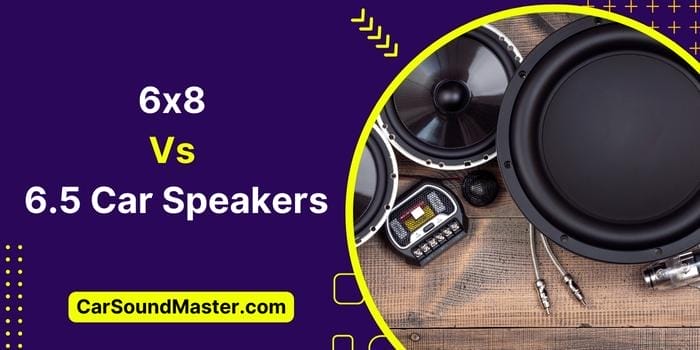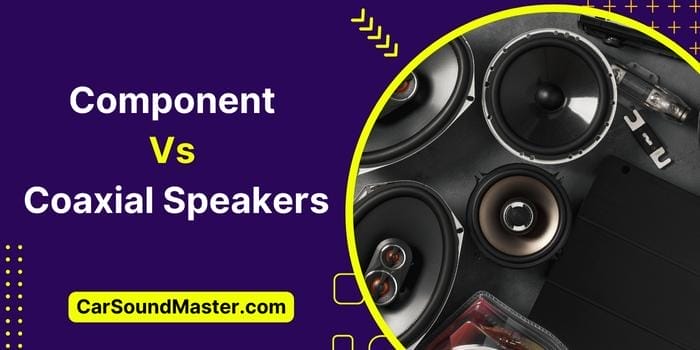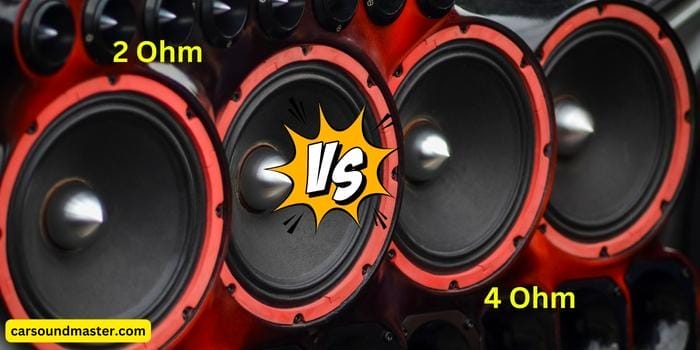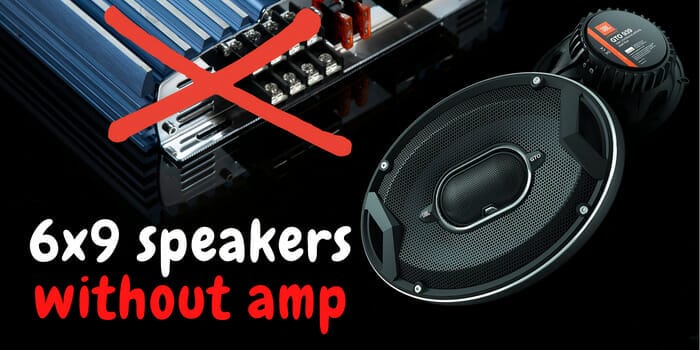6×8 Vs 6.5 Car Speakers – Which One is Best for You?
Go to the market to hone your car’s stereo setup (by replacing the stocks) and you’re up to choose from a humongous array of aftermarket sound suites.
However, if you’re much and more often into these things, you’d quickly break that wide array into (and decide from only) the big two i.e. 6×8 vs 6.5 car speakers.
But, what then? Who’s the winner of the 6×8 vs 6.5” contest?
I say the 6.5 components are always the better of the two. Compared to 6×8, the 6.5” are less expensive, require less RMS and peak power, offer more stable and crisp sounds, help with custom driver mountings, and are the perfect OEM replacements more often than none.
Whereas, for 6×8 speakers, their only edge over 6.5 components is their oval cones that make for a maximum surface area to cover extended frequencies.
What else? Let’s see in detail.
6×8 Vs 6.5 Car Speakers
A comparison between any two things is always, kind of, not an easy job to do as you’ve to factor in a lot of aspects, areas, elements, etc. While comparing these two speaker types, we will again be taking note of a lot of deciding factors.

For example, their pricing, power & impedance ratings, sound stability & frequency ranges, sensitivity, drivers’ suites, compatibility, and more.
#1. Sound Quality and Frequency Ranges – It’s Influenced by the Speakers’ Shape
Ideally, we should be starting with this very factor as it actually has the biggest impact on your purchase decisions.
The 6×8 Speakers
As is obvious through the name, 6×8 speakers always flaunt a bigger size than the 6.5. This makes them offer a maximum surface area at the conus which helps in covering a bigger range of frequencies.
This means a 6×8 component can throw a bit louder (high-frequency) sounds and somewhat more bass (low-frequency waves) as well. The frequency response range of typical 6×8 speakers lies anywhere between 55Hz and 22KHz.
However, because 6×8 speakers come with oval cones instead of rigid rounds, they don’t have stable sounds – and we call it “coloration”.
The reason for 6×8’s more coloration to the sound is simple – the speaker’s body has no even grip on the cone sheath (because it’s not evenly round) and therefore bursts or slumps in frequencies result in distortion of the cone’s shape.
Hence, the sounds out of these speakers are more often manipulated by over or undertones and resonance or free-air frequencies.
The 6.5 Speakers
Unlike 6×8 components, 6.5 speakers measure smaller in size and almost always come with rigid round cones.
The smaller surface area of a 6.5’s conus means smaller frequency range coverage and thus, all things equal (i.e. power, resistance, enclosure), a 6.5 speaker may produce a bit dim and low-bass sounds. But unlike the elliptical cone of 6x8s, the round cones here make for more crisp output and a definite output stability.
The frequency response range of these speakers can be as low as 40Hz and as high as 20KHz.
And to be straightforwardly honest, no one in the first place would ever think about a 6.5 speaker’s bass output. These are (small-sized) mid-range drivers supposed to output notes from just the mid-range of the spectrum and not touch very high highs or extreme lows.
#2. 2-Way, 3-Way Coaxial and Components – Adjustable Mountings
Coming in multiple build patterns (i.e. coaxial, separate, stackable components) and boasting different properties, let’s see how both these speakers do in the drivers’ customizations department.
The 6×8 Car Speakers
Because a 6×8 speaker comes with an elliptical/oval cone which is easy to lose its shape with abrupt ups or lows in the frequencies, you’d generally find the 6×8 drivers in coaxial/single-assembly builds.
They usually pack a tweeter above the bass speaker connected via a simple crossover i.e. a series-connected single small capacitor which also helps protect the tweeter(s).
It doesn’t mean there are no 6×8 “component sets” available in the market. You can find both 2-way and 3-way components in this speaker size which means you’ve got the customized driver mountings option here as well.
Unlike a coaxial, a component set allows you to manipulate the placement of drivers but because a 6×8 speaker’s output is always a bit unstable (due to non-rigid conus), no manipulations would be of much benefit in these speakers.
The 6.5 Components
Many 6.5” car speakers also come in the coaxial make pattern which means a single-assembly tweeter over woofer wired via a simple crossover.
However, because 6.5 speakers feature rigid round cones that make for much clearer and stable sounds no matter what, here you can effortlessly choose from both 2-way and 3-way components.
The benefit of components is that they can be customized; you can manipulate your tweeter’s and bass driver’s mountings as per your viewpoint of perfect sound imaging. The 2-way component set includes 2x woofers, 2x tweeters, and 2x crossovers as well.
Plus, with 2-way 6.5 components, the 2x crossovers also help in one acting as a high-pass filter for the tweeter, whereas the other as a low-pass filter for the bass driver. So these speakers would sound way better than any typical 6×8 car speakers.
In addition, if you could manage a place for mounting mid-range drivers as well in your car, you should ideally go for the kill – a 3-way 6.5” component.
#3. Power, Impedance, Sensitivity – Ratings and Requirements
Coming to the performance, let’s see which of the two speaker types is more economical.
The 6.8 Speakers
In automobile audio systems, 4 Ohm is usually the norm. That said, car speakers are almost always rated for an impedance of 4 Ohms only. The sensitivity though of 6.8 car speakers ranges somewhere between 87dB (1W/1mm) to 95dB – a big gap between the two extremes.
As far as wattage is concerned, the RMS rating of 6×8 speakers can range anywhere between 130W to 220W. Whereas, the peak power draw of these speakers may be as high as 350 watts. These high power ratings aren’t a disadvantage though as they directly translate into the maximum power-handling capabilities of typical 6×8 speakers.
RMS means the amount of power the speakers draw continuously to stay up and running. On the contrary, peak power is the max they may draw at times of frequency bursts and high kicks.
The 6.5 Car Speakers
The impedance here again would be 4 Ohms and the sensitivity is also pretty alike – it’s, maybe, a bit more stretched here i.e. between around 89 to 93 dB.
Nevertheless, the 6.5” components can handle not as much power as 6x8s. One reason may be their small size. However, the 6.5 car speakers are usually rated at 50W to 100W for RMS and 120W to around (or a bit over) 300W for peak power draw.
This can be an advantage and a disadvantage both at the same time. Advantage, that it makes the 6.5s more power-efficient; the disadvantage, because they may not match up with some high-end amps – just in case.
#4. Pricing and Compatibility
Let’s compare.
The 6×8 Car Speakers
Compared to the 6.5” components, 6×8 car speakers can be somewhat expensive. As for the compatibility factor, most 6×8 speakers feature a mounting depth of around 2.5 inches making them compatible with a wide range of big vehicles only. For example, SUVs, Hatchbacks, Ford’s big boys, trucks, etc.
Usually, most 6×8 speakers come with speaker grills and are built to comfortably sit beneath your vehicle’s factory panels and flaunt much efficiency in almost all cars. But if you’re planning to install one of these in your Sedan-type car, you’d probably need a custom-made big hole for them to fit in.
The 6.5 Speakers
Available for comparatively lesser bucks, the 6.5 car speakers are probably one of the perfect go-to options for an individual looking for their OEM’s stock replacement. By default, the factory size of so many car speakers is also 6.5”.
Due to the optimal size of these speakers, they often easily go into the doors of most vehicles making for a bit more extensive compatibility as compared to 6x8s.
You might also be interested in reading Component Vs Coaxial Speakers Comparison.
Final Thoughts
If bought within the same brand name, company, and maker, the relative performance of 6×8 and 6.5 car speakers shouldn’t be much different.
Subject to a few conditions, for example, the same vehicle size, equally facilitating enclosures, and the same power and other thrusts, a 6×8 may sound a bit louder with a bit more bass as well.
But again, that’s mainly due to their bigger cone sizes and maximum power draw compared to smaller 6.5” speakers. Apart from that, you’ll find the 6.5 car speakers winning the most of this very contest.
Anyway, there may be a lot more other factors for you to consider as well so that you can make a much more informed decision. But the four discussed above are the hotdog important for you to decide the winner of the “6×8 vs 6.5 car speakers” contest.
Have a nice day.







